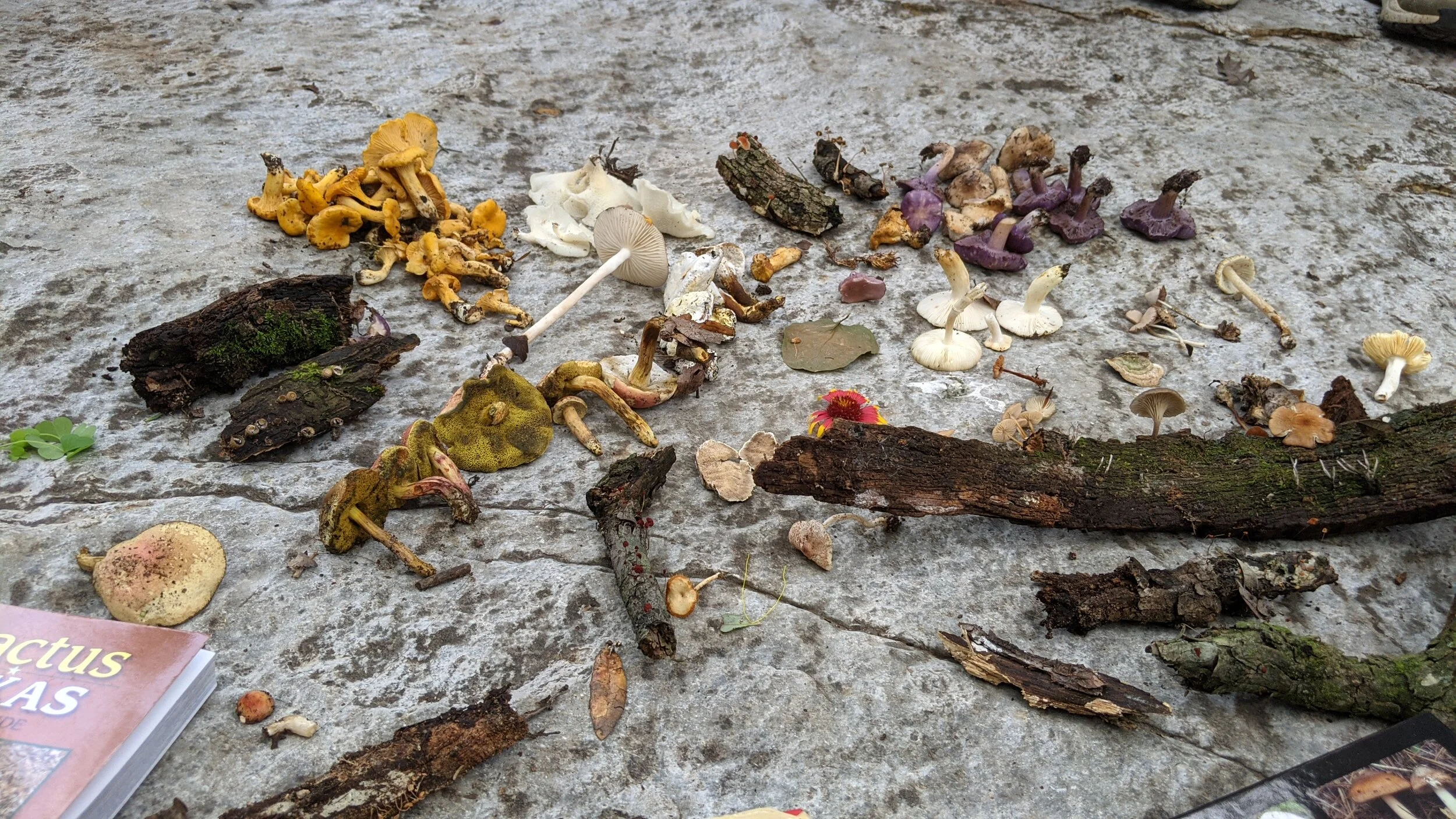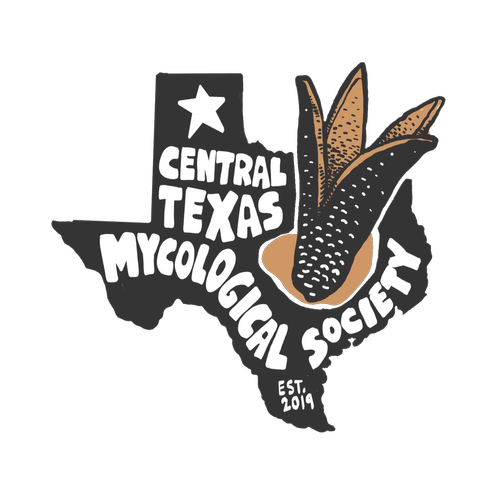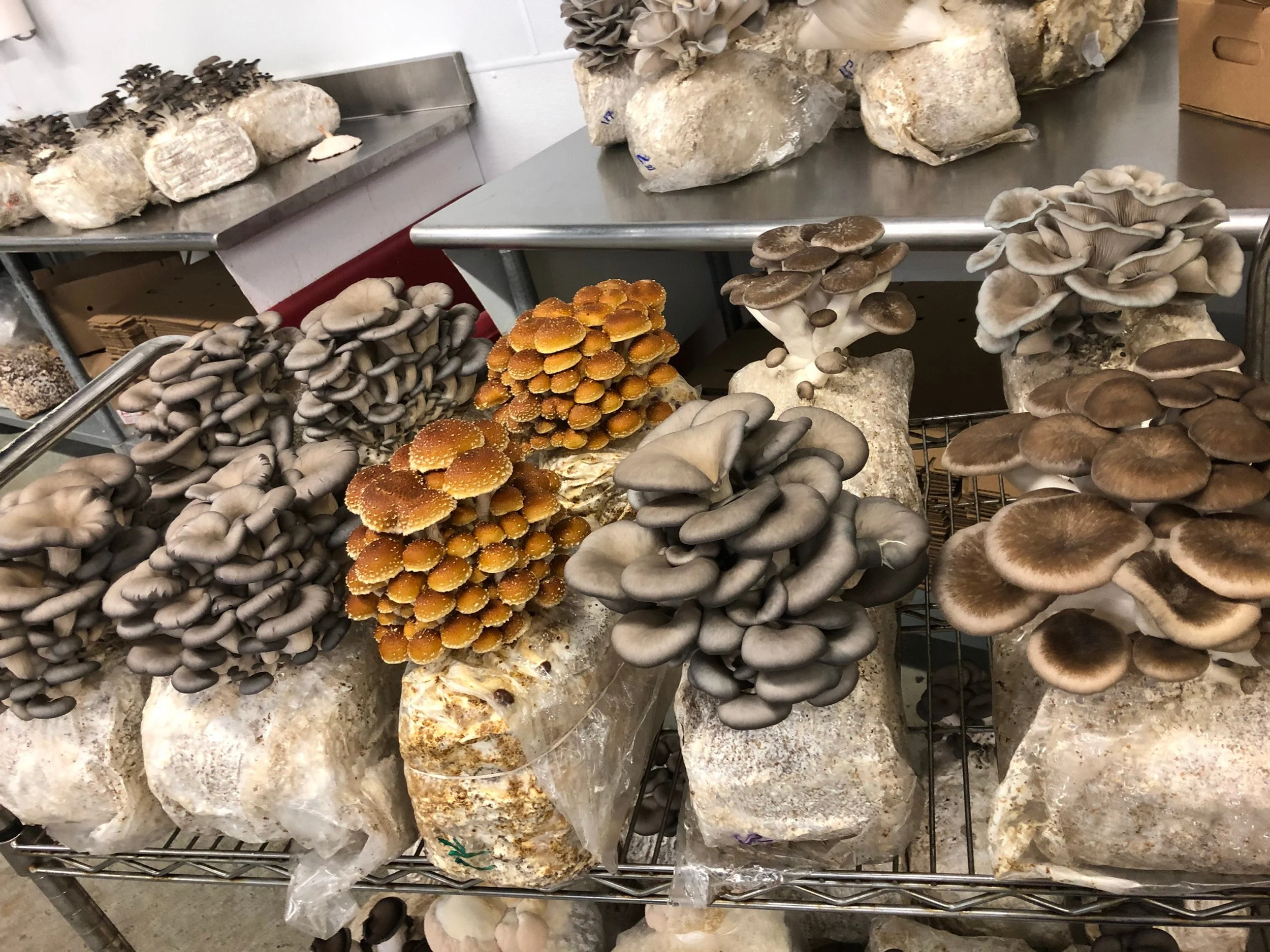As temps start to cool and trees start to loose their leaves, we start to look for the orange polypores known as Chicken-of the-Woods (COTW) Laetiporus sulphureus. Keep a look out on older Texas Live Oaks that have been trimmed and have their heartwood exposed. Spores are everywhere and carry a lot of genetic information that helps them find the right place to feast. COTW slowly eats the heartwood of Texas Live Oaks that are still alive. If you have ever seen a hollow tree, it is likely due to a fungus parasitizing a tree. Many times it’s not the fungi that is at fault. Human disruption, cutting down tree, and trimming of trees for roads and buildings, opens the tree up to the spores that are floating everywhere and waiting for the right opportunity to have dinner.
PHOTOS: Marysol Mushrooms Leo Birthday Bash
Marysol filled out mushroom lovin' hearts this weekend at the Leo Birthday Bash! Here are a few photos from the fungi-filled day in Bastrop. We were also joined by Erin from Shroomtownof Houston and Andrew @southtexasseasonals of San Antonio area! Members from the DFW area also joined! Texas hyphaes myceliating!
The day included a foray on the 5-acres behind the farm in the beautiful loblolly pines. Before we entered the forest we spotted several fruiting bodies popping up. #HONGOSTO!!
The walk was followed by a delicious lunch catered by Storehouse Market and Eatery in Bastrop. 😘
The main event was the tour of Marysol's new mushroom farm in a converted shed! You were so impressed by her and Jeff's hard work. Wow! You can pickup Marysols mushrooms at the @farmeredeneast and Boggy Creek farm stands in Austin and Bastrop.
Happy Birthday Marysol!
PHOTOS: Orchid & Mushroom Walk on July 31st
Sam the Fungi and I (Angel) had so much fun meeting everyone yesterday and looking for mushrooms and tuning into the beautiful orchid Hexalectris nitida or Glass Mountain Crested Coralroot
August Forage Forecast
Look for Ganoderma, the "Mushroom of Immortality" on dying or dead Pecan trees or stumps. If the top of the shelf looks red and varnished and the underside is still white, it is still good to harvest for medicinal purposes. The species shown above is more likely to be found in East Texas and in Bastrop area.
PHOTOS: Orchid & Mushroom Walk
Sam the Fungi and I (Angel) had so much fun meeting everyone yesterday and looking for mushrooms and tuning into the beautiful orchid Hexalectris nitida or Glass Mountain Crested Coralroot
PHOTOS: Foray at Bull Creek
So many smiles at the foray at Bull Creek that I shared with Sam theFungi and Central Texas Mycology members. The Cantharellus, Favolus and Hortiboletus continue to make an appearance because of the rainy, tropical, sauna-like weather. We also observed some other interesting fruiting bodies that I had not seen before in Central Texas. View slideshow of mushrooms that we added to iNaturalist.
July Forage Forecast
Look for Ganoderma, the "Mushroom of Immortality" on dying or dead Pecan trees or stumps. If the top of the shelf looks red and varnished and the underside is still white, it is still good to harvest for medicinal purposes. The species shown above is more likely to be found in East Texas and in Bastrop area.
PHOTOS: Myco-blitz at Balcones Canyonland Preserve
Thanks to Jeremy Hull @bluetip84 and everyone from Balcones Canyonland Preserve @bcp_traviscounty for having us out for our first Myco-blitz! We are so grateful for all of the volunteers that joined us and observed the cycle of mushroom life with us! Even though things are starting to get toasty we observed a lot of diversity of mushrooms and logged the photos on iNaturlist.org.
Here is a slideshow of a few of the observations. You can find more on iNaturalist.
1. Group photo of volunteers
2. #Dacrymycetaceae Jelly fungus
3. Huge cross section of #Xylaria #deadmansfingers. We spotted quite a few different species of this fungus in various stages of growth.
4. #Omphalotussubilludens #jackolanternmushroom This mushroom glows in the dark and you can check out @chungwei3wei beautiful photography of this bioluminescence mushroom.
5. We found several dried #Cantharellus Chanterelles next to different types of oaks including Live Oaks and maybe Post Oaks. Some were even growing under a tarp that was being used in a restoration project to remove an invasive ground cover.
6. #Sarcoscyphaaustriaca #scarletelfcup
7. #Pleurotusostreatus #oystermushroom
We can't wait to come back after the next good rain and continue to explore the biodiversity!
June Forage Forecast
As we continue to get rain, keep a look out for Chanterelles, the popular edible mushroom Cantharellus. In Central Texas, they are symbiotic with older Texas Live Oak trees that have a lot of leaf matter, making the ground spongy. Trees near creeks and where water is flowing is very important. Chanterelles need a lot of rain to fruit and they like the torrential Texas-style flash floods. They are orange, yellow or even white, meaty and funnel-shaped and can be found in clusters but most of the time they are found popping up as individual mushrooms as shown in the picture. On the lower surface, underneath the smooth cap, most species have rounded, forked folds that run almost all the way down the stipe, which tapers down seamlessly from the cap. Many species emit a fruity aroma, reminiscent of apricots, and often have a mildly peppery taste. The Jack-o-lantern, Omphalotus illudens is considered the false chanterelle in Texas so be sure to know the morphology and difference. They do sometimes grow around the same time of year but their habitat and morphology is different.
Auricularia or wood ear an edible jelly fungus pops up on downed hardwood limbs a few days after a good rain. Wood ear mushrooms are a popular ingredient in many Chinese dishes such as hot and sour soup, and are also used in Chinese medicine. It is also used in Ghana as a blood tonic. Modern research into possible medical applications has variously concluded that wood ear has anti-tumor, hypoglycemic, anticoagulant and cholesterol-lowering properties.
Favolus, or honeycomb fungus, is a genus of fungi in the family Polyporaceae. The fruit bodies of Favolus species are fleshy with radially arranged pores on the underside of the cap that are angular and deeply pitted, somewhat resembling a honeycomb. I tried a new recipe recently that has the taste and texture of chicharrones or pig's ears. I also discovered a new paper about its edibility. You can read more about it on our blog.
The Lobster mushroom, Hypomyces lactifluorum, contrary to its common name, is not a mushroom, but rather a parasitic ascomycete fungus that grows on certain species of mushrooms, turning them a reddish orange color that resembles the outer shell of a cooked lobster. H. lactifluorum specifically attacks members of the genera Lactarius and Lactifluus (milk-caps), and Russula (brittlegills), such as Russula brevipes and Lactifluus piperatus in North America. At maturity, H. lactifluorum thoroughly covers its host, rendering it unidentifiable. I spotted the Lobster shown in the photo on July 4, 2019 after we had consistent rain. Just yesterday, I spotted fresh Lactarius and Russula mushrooms. And if we continue to get rain, Hypomyces may be parasitizing these mushrooms. Several members of the community including Hi-Fi Myco have already seen them this year!
Lobster mushrooms are widely eaten and enjoyed fresh.They are commercially marketed and sometimes found in grocery stores. They have a seafood-like flavor and a firm, dense texture.
Old-Man-of-the-Woods, Strobilomyces strobilaceusttet is one of North America's most unusual edible wild mushroom. It is a dark, scurfy fungus that is gray-white with tufts of black hair on the cap and a fine layer of dark fur on the mushroom's stem. The species is in the Boletaceae family which means it has pores. They are small; angular; grayish, bruising reddish then black. The stalk is slightly narrower toward the cap usually with one or two ring zones. The partial veil is grayish and sometimes it leaves woolly ring zones on the stalk. It grows on the ground in mixed hardwood forests and on occasion under a conifer. It especially likes oaks.
Not a choice edible but the young fungi have a mellow, earthy flavour. Must be cooked.
As always, if you are trying a new mushroom, confirm the ID with an expert, then try a small amount to make sure you don't have an allergic reaction. Texas Mushroom Identification Facebook group is great for quick responses and ID help. Also, don't forget to add your finds on the Mushrooms of Texas project on iNaturalist.
Follow my foraging adventures @forage.atx.
PHOTOS: Zilker Mushroom Project: Chanterelle Dreams & Purple Mystery Mushroom
🌌🍄🌟 Cosmic!!! Magic!!! Here a some photos from the member foray at Zilker Park on Sunday May 30, 2021. The Zilker Park trails were TEAMING with mushrooms especially mycorrhizal fungi that surfaced with the continuous rain.
We observed 11 new species in the area of the Zilker Mushroom Project on iNaturalistt bringing the total number to 89 species observed.
We will be sending the purple speckled “cosmic” species off to get DNA analysis by Alan Rockefeller. We thought it was a #cortinarious species but the spore print is white (cortInarious has rust colored spores)! Jared McRay @jredeye311 gave us some tips and we think it is a mushroom from Africa in the Asproinocybe genus.
There were A LOT of chanterelles flushing and we will be sending a specimen to David Lewis for analysis and to store in the herbarium at Texas A&M.
With all the continuous rain, we hope to hold another member foray soon. If you're not yet a member, now is the time to jump on it!! As Sam the Fungi would say "LET'S GO!!!"














































































